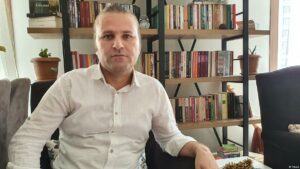A local court has sentenced a photojournalist who took photos of a university student being shot to death by a police officer in southeastern Turkey in 2017 to one year, six months and 22 days in prison on charges of “disseminating terrorist propaganda,” the Gazete Duvar news website reported on Thursday.
In 2017 Abdurrahman Gök took a series of photographs showing Kemal Kurkut, a Kurdish university student, being shot to death by a police officer during Nevruz celebrations in Diyarbakır and faced an investigation a month later. In 2018 after a decision of non-prosecution was issued, Gök was the subject of another investigation and was interrogated by the police, during which he learned that his communications had been monitored by law enforcement for a period of time.

Gök was detained a week after the interrogation and was released pending trial.
Seeing that the charges against him are based on journalistic material he shared with his colleagues, Gök reasons that the investigation is really about the photos he took at the 2017 Nevruz celebrations.
Facing 20 years in prison on charges of “membership in a terrorist organization” and “disseminating terrorist propaganda,” Gök was handed down just over one and a half years behind bars on terrorist propaganda charges by the Diyarbakır 5th High Criminal Court on Thursday. The court did not suspend the sentence, Duvar said.
Gök underlined in his written defense that the photos taken from his Instagram and Twitter accounts, which the prosecution claims to have constituted a crime, are the ones he took for news purposes while he was working as a photojournalist in conflict zones.
Referring to the photos he took in the Syrian towns of Kobani and Raqqa, Gök argued that even if the people in the photos are members of a terrorist organization, it was contrary to reason and the law to claim that he disseminated terrorist propaganda by covering news regarding them.
“The prosecution insists on making an assessment by separating me from my journalist identity. In my posts, there is no information other than where and when the photos were taken. Therefore, I wonder if I had written ‘Libya,’ ‘Al Bab,’ ‘Idlib,’ ‘Latakia’ or ‘Azerbaijan’ under these photos instead of Kobanê, would the prosecution still be able to argue that I was spreading ‘[terrorist] organization propaganda’ with these photos? I don’t think so,” he added.
The photojournalist also said, “Here, law enforcement and then the prosecution is trying to take revenge on me ‘on behalf of the state’ for exposing a lie by publishing the photos of Kemal Kurkut, who was announced to the public as a ‘suicide bomber.’ This is because I had published photos denying the statements of … the then-governor of Diyarbakır and the Ministry of Interior, which defended those responsible for this murder.”
The photos from Gök’s camera were crucial in refuting claims made by the Diyarbakır Governor’s Office following the incident that Kurkut had been shot on suspicion of wearing a suicide vest.
They showed a bare-chested Kurkut approaching a police checkpoint with a knife and a water bottle in his hands, then running past police barricades with several officers chasing after him before finally getting shot in the back and falling to the ground.
“Everybody knows it: His real ‘crime’ is to photograph the moment when Kemal Kurkut was killed by a police bullet…” journalist Can Dündar tweeted on Thursday, referring to the sentence handed down to Gök.
Herkes biliyor:
Asıl “suç”u, #KemalKurkut'un polis kurşunuyla öldürülme anını fotoğraflamak…#AbdurrahmanGök https://t.co/he31t872qJ— Can Dündar (@candundaradasi) June 30, 2022

